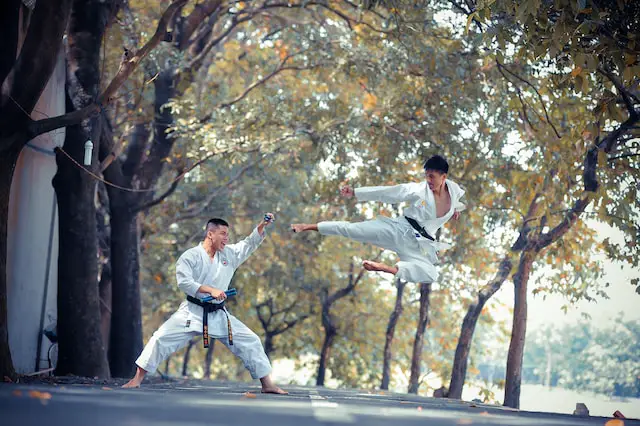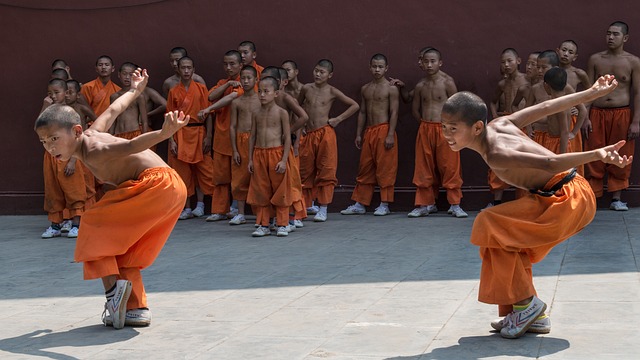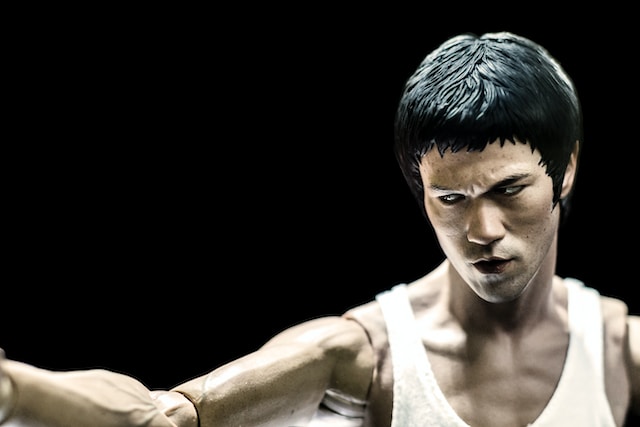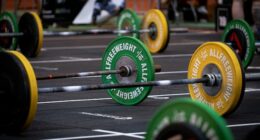Karate and kung fu are two distinct martial arts styles that originated in different parts of the world. While both have similarities in terms of technique and philosophy, there are notable differences between them. Karate typically emphasizes straight punches, kicks, and blocks while kung fu focuses on circular movements and incorporates more joint locks and throws.
What is karate?
(Photo by Thao LEE on Unsplash )

Karate is a martial art that originated in Okinawa, Japan. It is a striking-based style that emphasizes speed and power. Karate movements are often characterized by quick punches, kicks, and strikes delivered with precision and force.
One of the unique aspects of karate is its emphasis on using the body’s natural weapons – such as fists, elbows, knees, and feet – to execute techniques effectively. Practitioners also learn how to use their entire body when attacking or defending themselves.
As an art form that promotes discipline and self-control, karate has become popular worldwide for both sport competition and personal fitness training. In fact, many people take up karate not only to improve their physical strength but also to enhance their mental focus.
Karate can be a great way to develop your athleticism while learning practical self-defense skills from a respected martial arts tradition.
What is kung fu?
(Image by Manfred Bieser from Pixabay)

Kung fu is a Chinese martial art that has been around for thousands of years. The term “kung fu” means “skill achieved through hard work and practice.” It encompasses various fighting styles, techniques, and philosophies.
One of the most distinguishing features of kung fu is its emphasis on fluid movements and acrobatics. Practitioners often perform impressive jumps, kicks, and flips as part of their training routines. Kung fu also places great importance on balance, coordination, and flexibility.
Another key aspect of kung fu is its focus on internal energy cultivation. This involves practicing qigong exercises to develop the flow of energy throughout the body for both physical health and spiritual growth.
Kung fu training includes learning different forms or sets which are sequences of movements designed to improve technique while also developing strength and endurance. In addition to hand-to-hand combat techniques such as blocks, punches, kicks, throws; weapons such as swords or staffs may be included in some styles.
Overall, kung fu emphasizes self-discipline, persistence, and respect alongside physical strength making it an incredibly comprehensive form of martial art that contributes greatly to one’s overall well-being
Karate Vs. Kung fu – Key differences
When it comes to martial arts, karate and kung fu are two of the most popular styles. While they may have some similarities, there are also several key differences that set them apart.
One of the main differences between karate and kung fu is their country of origin. Karate originated in Okinawa, Japan while kung fu has its roots in China.
Another difference lies in their basic techniques. Karate tends to focus on strikes with the hands and feet, whereas kung fu places more emphasis on fluid movements and acrobatics.
In terms of training methods, karate typically involves a lot of repetition for perfecting technique and kata (a sequence of movements). Kung fu training often includes sparring drills as well as forms practice.
Philosophically speaking, Karate emphasizes discipline and respect while Kung Fu focuses more on spiritual development through meditation practices.
Both karate and kung fu offer unique benefits for practitioners. It ultimately depends on personal preference when choosing which style to learn.
Which is better for self-defense: karate or kung fu?
When it comes to self-defense, both karate and kung fu have their own unique set of techniques that can be effective in different situations.
Karate focuses on powerful strikes using the hands, feet, elbows, and knees. It also emphasizes blocking and countering attacks. This makes it a great choice for close-range combat situations where quick reflexes are essential.
On the other hand, Kung Fu is more versatile with its focus on throws, joint locks, grappling techniques along with striking. This makes Kung Fu an excellent option when dealing with larger opponents or multiple attackers.
It’s important to note that both martial arts require proper training and practice to be effective in real-life self-defense situations. Techniques learned from these disciplines should only be used as a last resort when all other options have failed.
Whether you choose karate or kung fu for self-defense depends on your personal preference and situation. Both offer valuable skills that can help protect you in dangerous scenarios if trained correctly.
Which is better for fitness: karate or kung fu?
When it comes to fitness, both karate and kung fu offer a great workout. Both martial arts require strength, agility, flexibility, and endurance. However, the specific techniques used in each discipline may lead to different areas of focus for your body.
Karate emphasizes explosive power and speed, which means that training involves a lot of high-intensity movements such as fast kicking and punching drills. This makes karate an excellent choice if you’re looking to improve your cardiovascular health while building muscle tone.
Kung fu focuses more on fluidity of movement and developing inner strength through meditation and breathing exercises. Kung fu training often involves low-impact moves that emphasize balance and coordination rather than brute force. As a result, practicing kung fu can help you improve your overall flexibility while promoting mental clarity.
Ultimately, the best martial art for fitness depends on what you want to achieve with your workouts. If you enjoy fast-paced routines that challenge your limits physically then Karate might be ideal for you – but if mindfulness is what interests you most then Kung Fu could be the perfect fit!
Who is the father of kung fu?
Kung fu is a martial art that originated in China and has since spread across the world. It has been practiced for thousands of years, with various styles and techniques developed throughout its history. But who is considered to be the father of kung fu?
There isn’t one single person who can be credited as the father of kung fu. The development of this martial art was a gradual process that involved many individuals over many centuries.
However, there are some notable figures in the history of kung fu who have contributed significantly to its development. One such figure is Bodhidharma, an Indian monk who traveled to China around 520 AD and introduced Chan Buddhism to the country.
Legend has it that Bodhidharma taught exercises to improve physical health and meditation practices to calm the mind during his time at Shaolin Temple in Henan Province. These exercises formed the basis for what later became known as Shaolin Kung Fu.
Other prominent figures in the history of kung fu include Zhang Sanfeng, Wong Fei-hong, and Ip Man – all of whom made significant contributions to different styles or schools within kung fu.
While there may not be a definitive “father” figure when it comes to kung fu, it’s clear that this martial art has a rich history filled with influential thinkers and practitioners who have helped shape it into what we know today.
Who is the father of karate ?
The question of who is the father of karate has been a topic of debate for many years. While many people believe that Gichin Funakoshi, the founder of Shotokan Karate, is the father of modern karate, others argue that this title belongs to Chojun Miyagi or Kenwa Mabuni.
Gichin Funakoshi was born in Shuri, Okinawa in 1868 and began studying karate at a young age. He went on to develop his own style which he called “Shotokan” and became known as the “father of modern karate”. His teachings emphasized physical fitness, mental discipline, and spiritual development.
Chojun Miyagi was another influential figure in the development of modern karate. He founded Goju-ryu Karate after years spent studying both traditional Okinawan martial arts and Chinese martial arts styles like Fujian White Crane.
Kenwa Mabuni was also an important pioneer in developing modern-day karate. He combined elements from various Okinawan styles to create his own unique system which he called “Shito-ryu”.
While there may not be one clear-cut answer as to who exactly deserves the title “father” of karate – what’s apparent is that these three individuals played an instrumental role in shaping its evolution into what it is today.
Who is No 1 kung fu fighter?
The question of who is the number one kung fu fighter is a highly debated topic. The answer may vary depending on who you ask, as there are many skilled and talented fighters in the world of kung fu. However, if we look at recent history and achievements, it’s hard to ignore the impact that Bruce Lee had on martial arts.
Bruce Lee was not only a skilled kung fu practitioner but also an actor, filmmaker, and philosopher. He developed his own style of martial arts known as Jeet Kune Do which combined elements from various styles including Wing Chun and boxing.
Lee’s physical prowess was undeniable; he could perform feats that seemed impossible for someone his size. His philosophy centered around using practical techniques that worked in real-life situations rather than adhering to traditional forms or rules.
Although he passed away at a young age, his influence can still be seen today through countless movies and TV shows featuring martial arts action sequences inspired by his unique fighting style.
While Bruce Lee may not technically hold the title of “Number One Kung Fu Fighter,” his contributions to the art form will always be remembered and celebrated by fans around the world.
Who is No 1 karate fighter?
Karate is an ancient martial art that has its roots in Okinawa, Japan. It has been practiced for centuries and has produced some of the most legendary fighters in history. When it comes to naming the No 1 karate fighter, there are a few names that come to mind.
One of the most prominent figures in karate history is Mas Oyama. He was the founder of Kyokushin Karate and gained worldwide recognition for his incredible feats of strength and skill. Oyama’s famous “one finger push-up” helped cement his place as one of the greatest karate fighters ever.
Another name that often comes up when discussing top karate fighters is Hirokazu Kanazawa. He was a student of Gichin Funakoshi, who is known as the father of modern-day karate. Kanazawa went on to establish his own style called Shotokan Karate and became an eight-time world champion.
Then there’s Joe Lewis, who was not only a successful fighter but also played a crucial role in bringing full-contact fighting to mainstream audiences. His accomplishments include being a three-time World Heavyweight Full Contact Karate Champion and winning numerous titles across different martial arts disciplines.
Determining who holds the title of No 1 karate fighter can be subjective since greatness can be measured by various factors such as technique, accomplishments or impact on the sport itself. Nonetheless, these individuals have undoubtedly left an indelible mark on karate’s history books with their outstanding performances and contributions to this discipline’s growth over time.
Featured Image By – Fervent Jan on Unsplash








